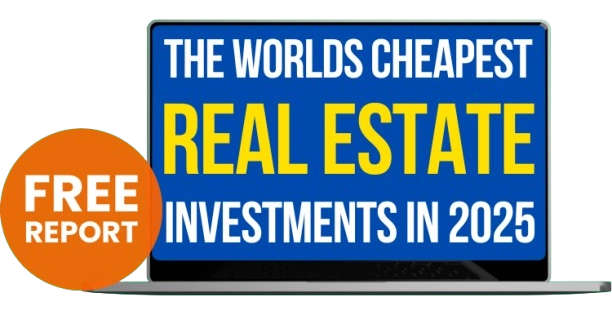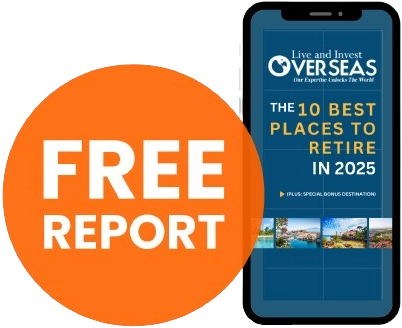The cost of holding real estate overseas can be as important a factor to bear in mind when considering a property as the initial cost of buying.
While property taxes, HOA fees, and other carrying costs are typically lower than for comparable properties in the United States, you still want to consider them in total before making any purchase. This is especially true if you’re an investor purchasing real estate for rental income.
For investors looking for rental yields, understanding the projected rental occupancy levels and rental rates is important, but you’ve got to be able to reasonably project your overall expenses (utilities, HOA fees, property taxes, taxes on rental income), as well.
This is a non-optional part of your overall due diligence checklist; the last thing you want to do is purchase a rental property overseas that’ll have you shelling out more cash than you’re bringing in.
In the United States, property taxes are usually the biggest cost of carrying a piece of real estate, but not all countries impose property taxes. For example, you’ll have no property tax as an owner in Croatia, Malta, or the Cayman Islands.
In some countries, you can take advantage of property tax exemptions ranging from 5 to 20 years on new construction projects. In other parts of the world, property taxes are negligible, maybe $100 or $200 per year. Your monthly utility expenses will depend on where you purchase your property.
In a place with a temperate climate like Medellín, Colombia, your utility expenses would be insignificant, as you don’t have to pay for either heating or cooling. On the other hand, in Panama City you’d have to factor in the cost of year-round air conditioning.
One of the most important carrying costs to factor into your monthly expenses is the Homeowners Association (HOA) fee. In some places, unlike the United States, this can be your biggest carrying cost and make up a huge chunk of your overall monthly budget.
I’ve seen HOA fees over $1,000 a month in ultra-luxury buildings in Playa del Carmen. That said, having a strong HOA in place is essential to preserving the overall value of your investment; the building or community that you’re buying into must be maintained.
But evaluating monthly HOA fees is not as straightforward as property taxes or utility expenses.
There are several factors to consider in addition to the actual fee when reviewing the HOA for a specific project…
HOA Fees For Pre-Construction Projects
When you buy in the pre-construction stage, the best the developer can do is give you an estimate of what the monthly HOA fee will be. Once everything is built and maintenance must begin, the actual cost is what it is.
If you don’t want to live in a building or community that deteriorates around you, you and your neighbors have no choice but to pay your share each month.
While no one wants to pay more than necessary for HOA fees, you also don’t want to be lured in by under-projected fees, only to have them go up substantially once the developer turns over maintenance to the owners. Again, the costs will be what they are.
If projected HOA fees don’t cover them, one of two things will result: the property will slowly deteriorate, or owners will be required to meet regular capital calls beyond the HOA amounts.
Unfortunately, not knowing exactly what your monthly HOA fee will be is one of the risks that you take purchasing in pre-construction.
Start Your New Life Today, Overseas
What To Look For In Existing Buildings Or Developments
If you’re buying into an existing building or development, then you first need to assess the overall property condition. Look at the paint, general appearance, the pools, the grounds, elevators, common areas, roads, and facilities. If the property is not in good condition, see it as a huge, red flag… and proceed with caution. A quality, well-managed property or building is never in a rundown condition, period.
You should also make sure that the HOA is well funded by reviewing their financial statements.
Has the HOA management created a reserve or contingency fund? Look at what they spend each year on maintenance and how much cash they have in the bank. Do the expenditures match the level of visible amenities and maintenance?
If you see a low bank balance and a minimal amount having been spent on maintenance annually, a couple of things could be going on…
If you see evidence of this, you should think about what your future exposure could be as an owner. It could be that the HOA fees do not adequately cover the cost of monthly maintenance, which means that the fees are too low.
Maybe you’ve got some owners that are not paying their monthly HOA dues.
Or there might’ve been a major repair that had to be done that depleted the reserve or contingency fund.
In addition to monthly HOA fees, you’ll sometimes have additional capital calls—also known as a special assessment—to cover extraordinary repairs
or improvements, which is why a reserve fund is important. Specifically, when buying into older buildings or developments (10 years or older), ask about deferred maintenance that will need to be caught up in the next couple of years.
You don’t want to be hit with a special assessment for repairs or maintenance during your first year of ownership. With a new building or community,
you won’t have to worry too much about a special assessment anytime soon.
If you do identify deferred maintenance that might lead to a special assessment early in your ownership, you can use this as a negotiating point when you make your offer.
Other Things To Look For When Reviewing HOA’s
First, establish whether HOA fees are charged as a fixed amount or on a per-square-meter basis.
In Latin America, it’s not uncommon for HOA fees to be charged on a per-square-meter basis. For example, we had a reader looking to buy in a new golf community in Panama… That is, until he discovered that the HOA fees were being projected at $2 per square meter. The HOA fee for the house he was considering buying, therefore, would amount to $1,700 a month.
Also, try to compare the fees to similar buildings or developments in the area to make sure that they’re not too excessive but are sufficient. On the other hand, be concerned if you find that the fees are unusually low—this will likely result in surprise assessments down the road.
Stay diversified,

Lief Simon
Director, Overseas Property Alert










